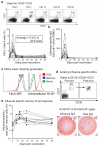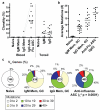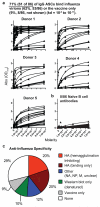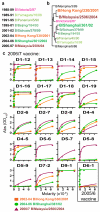Rapid cloning of high-affinity human monoclonal antibodies against influenza virus
- PMID: 18449194
- PMCID: PMC2515609
- DOI: 10.1038/nature06890
Rapid cloning of high-affinity human monoclonal antibodies against influenza virus
Abstract
Pre-existing neutralizing antibody provides the first line of defence against pathogens in general. For influenza virus, annual vaccinations are given to maintain protective levels of antibody against the currently circulating strains. Here we report that after booster vaccination there was a rapid and robust influenza-specific IgG+ antibody-secreting plasma cell (ASC) response that peaked at approximately day 7 and accounted for up to 6% of peripheral blood B cells. These ASCs could be distinguished from influenza-specific IgG+ memory B cells that peaked 14-21 days after vaccination and averaged 1% of all B cells. Importantly, as much as 80% of ASCs purified at the peak of the response were influenza specific. This ASC response was characterized by a highly restricted B-cell receptor (BCR) repertoire that in some donors was dominated by only a few B-cell clones. This pauci-clonal response, however, showed extensive intraclonal diversification from accumulated somatic mutations. We used the immunoglobulin variable regions isolated from sorted single ASCs to produce over 50 human monoclonal antibodies (mAbs) that bound to the three influenza vaccine strains with high affinity. This strategy demonstrates that we can generate multiple high-affinity mAbs from humans within a month after vaccination. The panel of influenza-virus-specific human mAbs allowed us to address the issue of original antigenic sin (OAS): the phenomenon where the induced antibody shows higher affinity to a previously encountered influenza virus strain compared with the virus strain present in the vaccine. However, we found that most of the influenza-virus-specific mAbs showed the highest affinity for the current vaccine strain. Thus, OAS does not seem to be a common occurrence in normal, healthy adults receiving influenza vaccination.
Figures




References
-
- Francis Thomas., Jr On the Doctrine of Original Antigenic Sin. Proceedings of the American Philosophical Society. 1960;104(6):572–578.
-
- Gerhard W, et al. Role of the B-cell response in recovery of mice from primary influenza virus infection. Immunol Rev. 1997;159:95–103. - PubMed
-
- Luke Thomas C., Kilbane Edward M., Jackson Jeffrey L., Hoffman Stephen L. Meta-Analysis: Convalescent Blood Products for Spanish Influenza Pneumonia: A Future H5N1 Treatment? Ann Intern Med. 2006;145(8):599–609. - PubMed
Publication types
MeSH terms
Substances
Grants and funding
LinkOut - more resources
Full Text Sources
Other Literature Sources
Medical
Miscellaneous

